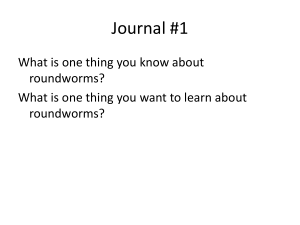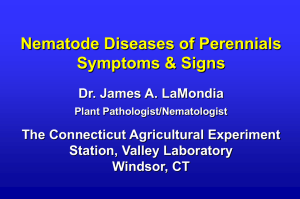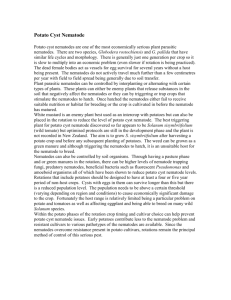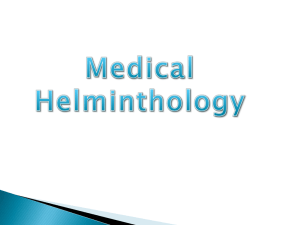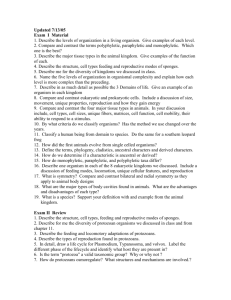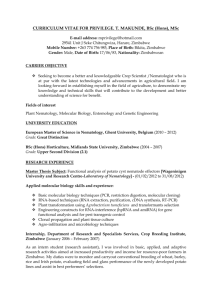Topic
advertisement
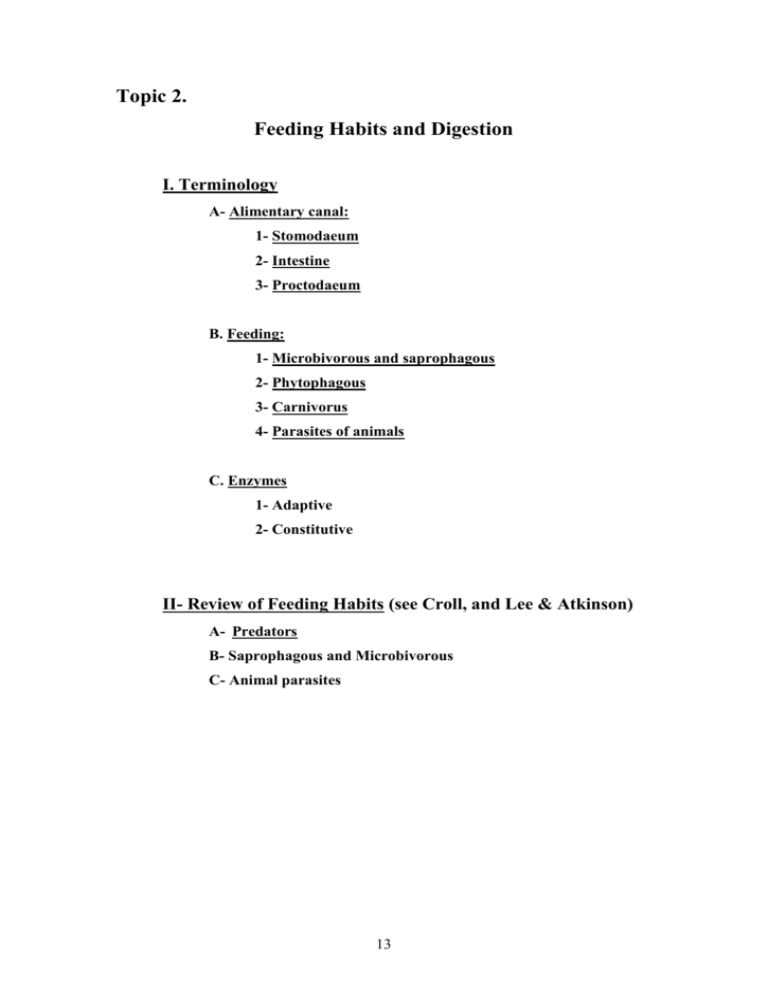
Topic 2. Feeding Habits and Digestion I. Terminology A- Alimentary canal: 1- Stomodaeum 2- Intestine 3- Proctodaeum B. Feeding: 1- Microbivorous and saprophagous 2- Phytophagous 3- Carnivorus 4- Parasites of animals C. Enzymes 1- Adaptive 2- Constitutive II- Review of Feeding Habits (see Croll, and Lee & Atkinson) A- Predators B- Saprophagous and Microbivorous C- Animal parasites 13 Topic 2. Feeding Habits and Digestion I. Terminology A- Alimentary canal: 1- Stomodaeum: includes mouth, lips, stoma (buccal cavity, ampulla) and esophagus (pharynx). 2- Intestine 3- Proctodaeum: consists of rectum and anus in females; or cloaca and its associated structures in males. B. Feeding: 1- Microbivorous and saprophagous: Feed on bacteria or products of bacterial decay. 2- Phytophagous: Feed on fungi, diatoms, algae and higher plants 3- Carnivorus: stylet or tooth-bearing nematodes that prey upon protozoa, nematodes, rotifers, tardigards, oligocheates, or even eggs of other nematodes. 4- Parasites of animals C. Enzymes 1- Adaptive: produced in response to the presence of given substrates, etc. 2- Constitutive: normally produced by an organism. II- Review of Feeding Habits (see Croll, and Lee & Atkinson) B- Predators These nematodes aid in maintaining the balance of nature among soil fauna. The most common among these are the mononchus, Mononchus and related genera, which occur in almost all soils and fresh water. They prey on other nematodes, rotifers, protozoa, other microorganisms, and sometimes devour their associate mononchs. Four other genera of predators are Nygolaimus, Sectonema, certain Dorylaimus spp. and Seinura spp. The first three genera are closely related, and feed primarily on oligocheates. Some report that these nematodes do not feed on other nematodes. The gelatinous matrix of some nematodes (such as cyst, rootknot and reniform nematodes) possibly acts to repel these predators. However, 14 Linford reported that at least 10 species of Dorylaimus such as D. carteri and D. serpentines feed on other nematodes. He concluded that predaceous Dorylaimus are more effective in reducing the nematode population of soils than are predaceous mononchs. Several species of the genus Seinura are predaceous and appear to feed largely, if not exclusively, on other nematodes or their eggs. These predaceous Aphelenchus insert the slender stylet and inject a secretion that paralyzes the prey almost instantly. B. Saprophagous and Microbivorus These are the greatest groups of nematodes inhabit marine and fresh water. Diatoms and algal cells have been observed in the guts of some species. Many of them probably feed on organic matter or organisms growing thereon. In feeding mechanisms, the fresh-water and soil nematodes probably are similar to the marine nematodes: those without teeth or stylet (Monhystera, Plectus and Cephalobidae) feed mainly on particulate food; those with teeth (Tripylidae, Mononchidea) are potential predators; and those with stylets (Dorylaimidae, Tylenchida) are predaceous or phytophagous. C. Animal Parasites Very numerous, ecto- and endoparasites. D. Phytophagous: 1. Lower plants: a- On lichens, liverworts, mosses and ferns - Aphelenchoides parientinus and Plectus parientinus on lichens, have the capacity to undergo anabiosis because they are subject to extreme drought. - Some Aphelenchoides spp. on liverworts, mosses and ferns. Occur in the moist environment. - Two Ditylenchus spp. cause galling (true parasites) on moses. - Aphelenchoides fragaria, endoparasitic on ferns. - Tylenchus davaini, a parasite of liverworts. - Some species of Triplya, Dorylaimus, Plectus, Monhystera, Alaimus are commonly found around liverworts and mosses. 15 b- On Algae: Tylencholaimus mirabilis and some Dorylaimus species feed on algae in the soil. In culture, Dorylaimus ettersbergensis feed on green and blue algae and on fungi and a protozoan. c- On Fungi: Species of Aphelenchoides, Aphelenchus, Ditylenchus, Neotylenchus and Hexatylus feed on fungi. In some cases, Aphelenchus avenae, Aphelenchoides campesticola, A. saprophilus, Ditylenchus intermedius, D. myceliophagous and D. triformis are probably primarily fungal feeders. D. triformis secrete cellulase and chitinase. 2- Higher Plants (see Al-Hazmi): a- Root ectoparasites: 1- Migratory - Xiphinema 2- Sedentary – Criconema b- Root semi-endoparasites: 1- Migratory – Hoplolaimus 2- Sedentray – Tylenchulus c- Root endoparasites: 1- Migratory – Pratylenchus 2- Sedentary- Meloidogyne d- Parasites of aerial plant parts: – Ditylenchus dipsaci III- Role of Sensory Organs in Feeding The sensory system in nematodes is so well developed that they can seek out specific plant parts: 1. Ditylenchus dipsaci – penetrates the root-stem junction of oats, etc. 2. Meloidogyne – the larvae enter the growing root of tomato, often close to the root cap and then soon locate the area of differentiating xylem. 3. Pratylenchus, on the other hand, often penetrate back of the root cap. 4. Aphelenchoides ritzemabosi, assends the stem and invades the leaves of mums. 5. Trichodorus, an ectoparasite, feeds on cells of the zone of elongation in roots of apple and cherry trees; as the root grows, a population accumulates at this zone and moves as the root grows until it is damaged and the nematodes then disperse. 16 6. The coconut palm (or red ring) nematode, Rhadinaphelenchus cocophilus is transported to its host by the palm weevil (or beetle) IV- General Types of Feeding (see Dropkin) A. Penetration Plant parasitic nematodes vigorously attack the cell walls at the plant's surface by repeated thrusts of the stylet. The opposing force may be provided by lip suction, or by a resistant surface against which the nematode body is braced. Stylet penetration into certain fungus cells is rapid, but root-knot larvae make repeated attempts to penetrate cells on the root surface. Nematodes may also enter tissues through natural openings such as stoma, or at breaks in the surface such as the points of emergence of secondary roots. B. Feeding 1. Little effect or damage on host cells Stylet of Tylenchorhynchus dubius cause little effect on its host cells when feeding on root hairs. A spherical mass forms at the stylet tip within the cells. The nematodes then remains quit for 30 seconds after which its bulb pulsates; the spherical mass diminishes in size and disappears after 1 minute. Tylenchorhynchus claytoni similarly does little damage on alfalfa cells. 2. Immediate removal of cell contents Paraphelenchus acontoides penetrates the cells of its host and withdraws their contents within 2 or 3 seconds. In other associations, however, the nematode remains at a single cell for long periods during which fluid probably enters the host cell through the stylet. 3. Delayed removal of cell contents The complete feeding cycles of Ditylenchus myceliophagous on Botrytis includes an injection period of about 40 minutes during which fluid from the esophagous glands empties from a reservoir (ampulla) just behind the stylet and passes through the stylet into a hyphal cell. Following this, the posterior esophagous pumps gently for about 40 minutes. The termination of feeding is marked by a very rapid action of the conspicuous muscular medium bulb for a brief period. 17 4. Progressive penetration The endoparasitic nematodes penetrate progressively. For example. Pratylenchus crenatus may first pierce cells of its host roots (bluegrass). After feeding on a given cell, the nematode penetrates the adjacent cell, feeds again and moves to another. This type of feeding, of course, cause lesions. V- Digestion A. Hydrolytic enzymes: Plant parasitic nematodes, like other animals, secrete enzymes which made available the essential nutrients required for their growth. Many of the characteristics of disease incited by nematodes are thought to be the result of enzyme action rather than mechanical damage alone to the host cells. The secretion of enzymes (hydrolytic enzymes) has been based on the following observations and analytical procedures: 1. Observations of feeding habits of nematodes and the manner in which they damage tissues 2. Histopathological studies. 3. Examination of water in which nematodes were suspended for enzymatic activity. 4. Crushing nematodes and testing the homogenate for enzyme activity. 5. Infecting sterile seedling and tissue cultures with aseptic nematodes and observing the type of damage. 6. Adding nematodes to cell-free media and examining the substrate for breakdown products. While all of these methods have limitations, the combined results obtained from these methods do suggest that hydrolytic enzymes digest cell substrates before they are ingested by the nematodes. Some of the enzymes detected in plant parasitic nematodes are: 1- Amylase 2- Cellulase 3- Pectic enzymes 4- Chitinase 5- Invertase 6- Protease 18 B. Other aids in digestion Nerve poisons, probably involves acetyl-cholinesterase in certain predatory nematodes (Sienura ?). However, Mononchus use mechanical maceration in feeding. 19

